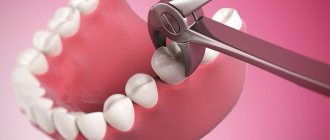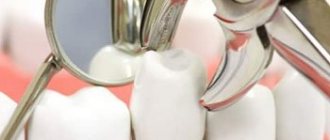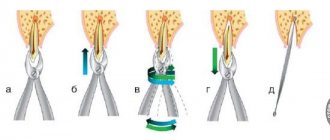It is not always possible to save a damaged tooth; sometimes it needs to be removed. Removing teeth without pain prevents inflammation in the mouth, protects adjacent teeth from destruction, and prevents caries. The dentists of our clinic strive to preserve the patients’ teeth as much as possible and rarely resort to extraction. But if necessary, they remove the tooth painlessly. Doctors carefully select anesthesia and use reliable drugs.
Removing the nerve of a tooth without pain
Cost of tooth extraction
Only a dentist can answer how much it costs to remove a tooth without pain during a free initial consultation. It takes into account complications: the position of the tooth in relation to others, its type, condition, indications and contraindications for the procedure, type of anesthesia.
Initial consultation
- Oral examination
- Making a treatment plan
- Drawing up a treatment estimate
For free
Cost of removing 1 tooth
- Anesthesia and pain relief
- Tooth extraction using a dental microscope
- Prevention of socket inflammation
- Postoperative examination
RUB 2,500
Indications for pain relief
Anesthesia for dental treatment is necessary if:
- minor surgical procedures;
- removal of one or more teeth;
- purulent inflammation of dental tissues;
- depulpation;
- periodontal inflammation and deep caries;
- neuritis or neuralgia of the facial nerve.
The drugs used by our clinic specialists are safe for health. But sometimes anesthesia during tooth extraction or treatment is impossible. The most common contraindications to pain relief: allergic reactions to painkillers, acute diseases of the cardiovascular system, diabetes, hormonal disorders. Your doctor will determine a treatment plan based on these factors.
The removal of wisdom teeth causes a lot of fears and concerns among patients. During their eruption, pain and purulent inflammation may occur, which require immediate treatment. Dentists at NovaDent clinics dispel myths about the pain of treatment.
Indications: when removal is necessary
Teeth have to be removed due to infections in the mouth that destroy the teeth. It is important to identify and treat such diseases in a timely manner. When therapy does not solve the problem, the tooth has to be removed.
Indications for the procedure:
- inflammation in the mouth
- root fracture,
- destruction of roots,
- gum injury,
- the need to make an arch on the jaw.
Tooth extraction is indicated for patients with periodontitis, cysts, and advanced caries. To prevent the problem, you should carefully maintain dental hygiene. The following also lead to extraction: its fractures, loosening.
General anesthesia is dangerous to health - is this true?
Preparations for general anesthesia do not consist of vitamins, but they cannot be called dangerous either. We use only certified, non-toxic materials that are quickly and completely removed from the body. In addition, general anesthesia is not used just like that; it is used in cases where tooth extraction without it will cause several times more harm than the anesthesia itself.
I saw a film where a man woke up during anesthesia and felt everything, but could not move. What if this happens to me too?
Such a plot is interesting, entertaining, successful with viewers, and due to the frequency of its use, it seems that this happens to every second patient. Actually no, intraanesthesia awakening rates are less than one percent! This happens due to the wrong combination of drugs - the sleeping pills stop working earlier, so the person wakes up, but cannot move. In modern medicine, such errors are excluded; the dose is calculated individually. In addition, the anesthesiologist monitoring the patient will notice changes in indicators and stop the operation.
Contraindications: when tooth extraction is not permitted
It is not always possible to perform tooth extraction without pain. The procedure should be avoided if the patient:
- there are acute diseases;
- you are pregnant in the 1st or 3rd trimester;
- there are diseases with local skin lesions (herpes, fungus, syphilis);
- diagnosed with mental illness;
- have blood diseases,
- radiation therapy is performed;
- There are cancers that are treated with chemicals.
In such cases, it is better to postpone the extraction.
Prices for tooth extraction under general anesthesia
| Service | Price |
| Combined inhalation anesthesia (1 hour) / B01.003.004.008 | 23 000 ₽ |
| Combined inhalation anesthesia (30 min) / B01.003.004.009 | 11 500 ₽ |
| Complex tooth extraction / A16.07.001.001 | 7 000 ₽ |
| Complex tooth extraction (category 1) / A16.07.001.002 | 9 500 ₽ |
| Complex tooth extraction (wisdom teeth) / A16.07.024.001 | 11 500 ₽ |
| Operation of removing impacted, dystopic or supernumerary teeth / A16.07.024 | 16 000 ₽ |
Tooth extraction procedure without pain
Many patients are apprehensive about the procedure. It is considered to be quite painful. But today dentistry is well developed to offer painless removal to the patient. During the procedure, the patient does not feel pain thanks to properly selected anesthetics. They reduce sensitivity in the mouth, so no pain is felt during extraction. The doctor can quickly remove the tooth from the alveolus without causing any discomfort to the patient.
Pain is reduced:
- general anesthesia,
- local anesthesia.
Under general anesthesia, several tooth roots are removed at one time. Local anesthesia is most often used. First, the doctor checks with the patient whether he is allergic to medications, then gives the patient an injection. It is very important to administer the injection correctly, otherwise you may numb the wrong area or not numb the tissue at all.
The most difficult thing to remove is wisdom teeth. When extracting it, it is necessary to use a stronger anesthetic. Such a tooth causes pain to the patient and puts pressure on adjacent teeth. And it is better to remove it on time.
Although extractions have been used for centuries, modern dental offices do not remove teeth as they did in ancient times. The procedure is performed with forceps, very carefully. A simple extraction is carried out when the doctor can catch the instrument on a section of the tooth protruding from the gums. Surgical tooth extraction is performed without pain when there is nothing to grab onto. Manipulations require an integrated approach. Pre-deposits on tooth enamel are removed using ultrasonic equipment. After the procedure, the patient is prescribed antibiotics.
Modern deletion doesn't seem so bad. An experienced doctor removes the tooth quickly and painlessly, without affecting adjacent teeth. To restore teeth rather than remove them, you should carefully monitor their condition and maintain oral hygiene.
Stages of tooth extraction under general anesthesia
The InWhite Medical clinic takes a very serious and responsible approach to performing operations under general anesthesia: all doctors have extensive experience in removing teeth under anesthesia, sedation and anesthesia, and the anesthesiologist never stops monitoring the situation for a minute.
Preparation
After consultation with a dental therapist and surgeon and a decision has been made to remove the tooth under general anesthesia, the patient is sent for a consultation with an anesthesiologist. The specialist individually calculates the dose of the drug based on diagnostics - blood tests, ECG, reports from a therapist and neurologist. Contraindications, if any, must be identified.
Removal of a tooth
Under the influence of the drug, the patient falls asleep, the anesthesiologist monitors health indicators (pulse, pressure, temperature, blood circulation), controls ventilation and proper breathing. At this time, the surgeon treats the oral cavity, removes the desired tooth, sutures the wound or puts medicine into the hole.
Awakening
20 minutes after the end of the operation, the effect of anesthesia wears off. The patient gradually wakes up, the anesthesiologist helps him come to his senses and restore independent breathing. After an hour, the person’s condition is completely stabilized, but weakness and dizziness are present, so it is recommended to go home with an accompanying person.
To successfully perform an operation and remove a tooth under general anesthesia, the efforts of the doctor alone are not enough; a conscious approach to the procedure is required from the patient himself. A person must tell a specialist about all medications taken, chronic diseases, and surgeries undergone. You cannot eat six hours before the procedure, and drink (even plain water) four hours before. After recovering from anesthesia, you cannot drive a car yourself.
Consequences of deletion
After removing the nerve of the tooth, the dentist can place an implant. Its implantation is carried out to prevent displacements and changes in the bite. It is better not to postpone this event.
After surgery, you need to take some measures to promote recovery. You should refrain from eating hot food for the next 4 hours, from cleaning, and from frequent rinsing. If noticeable swelling occurs, your temperature rises, or your breath begins to smell bad, you should visit your dentist.
You can have a tooth removed painlessly at the Dental Clinic "Dentist's Practice". Our doctors constantly improve their skills and participate in specialized seminars and conferences in Russia and abroad. We use the latest equipment and certified materials. In our clinic in Moscow, doctors use modern anesthetics and perform tooth extraction in the most comfortable manner for the patient. After extraction, the gums recover within a week. If necessary, the doctor may prescribe general anesthesia for severe pain, swelling, or high fever. Together with the anesthesiologist, the dentist carefully selects the type of anesthesia, taking into account the patient's characteristics.
We use safe medications that meet international standards and choose proven drugs. After surgery and treatment, our dentists consult patients and conduct follow-up appointments.
Types of dental anesthesia
In dental clinics, the following methods of anesthesia are used when removing a tooth or treating it:
- application - an initial remedy for superficial anesthesia of the oral cavity in the form of a gel or spray with an anesthetic;
- infiltration – drugs are injected into the gums;
- conductive - the medicine is administered in close proximity to the nerve endings, used in cases of complex surgical intervention;
- stem - blockade of all branches of the trigeminal nerve, used in a hospital setting.
In each situation, the dentist will choose the necessary anesthetic that will calm the patient and allow the procedure to be carried out without stress. For anesthesia during wisdom tooth removal, treatment of deep caries, and pulp removal, the infiltration method is often chosen.
Do you need painless treatment for inflammation in the oral cavity? Contact the NovaDent clinic! We will help you restore the health and beauty of your smile.
Expert of the article you are reading: Svetlana Viktorovna Derevyakina Chief physician, doctor of the highest qualification category, therapist, periodontist, leading specialist of the NovaDent network
28 years
Clinical experience
Petrovsko-Razumovskaya
Verkhniye Likhobory
st. Dubninskaya, 27, building 1
+7
Free consultation with this specialist
General anesthesia: indications and features
Anesthesia (general anesthesia) is the introduction of the patient into a deep medicated sleep, which involves complete pain relief. Before the procedure, the patient must undergo a special examination and pass the appropriate tests.
Our Moscow clinics also offer dental treatment under general anesthesia. The extensive experience of our specialists and the availability of the most modern painkillers at their disposal allows us to guarantee absolute comfort and painless procedures.
The main indications for the use of anesthesia include:
- Dentophobia;
- Uncontrolled gag reflex;
- Neurological diseases;
- Ineffectiveness of local anesthesia;
- The need to carry out complex operations;
- Large volume of upcoming manipulations;
- Installation of several implants at once.
Before starting dental treatment using anesthesia, you must visit a consultation with an anesthesiologist. Based on the results of the examination, he makes a final decision on the advisability of using this type of pain relief.
During the procedure under general anesthesia, the patient is in a state of deep sleep, so he simply cannot experience any unpleasant sensations. The person's condition is closely monitored by an anesthesiologist. Monitoring the vital signs of the body is provided by special equipment. Proven, highly effective means help minimize the negative effects of anesthesia on the body of a child or adult. Special means provide maximum comfort when the patient awakens. Within a few hours after treatment, he can leave the clinic on his own without experiencing pain.










